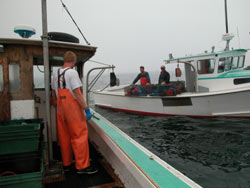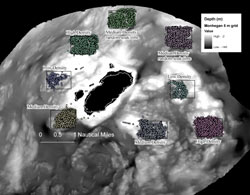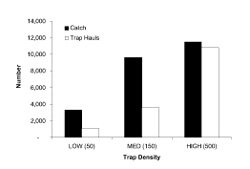
Monhegan lobstermen who participated in the trap density study observed that is was not exactly like fishing since they were setting in predetermined areas. Throwing all the lobster overboard was a bit strange for some. Photo: DMR |
Monhegan offered a valuable and unusual opportunity to study lobster biology and mortality. Since 1907 the waters within two miles of the island have been seasonally closed from December to June. This closure was made formal with legislation passed in 1998. It is the only seasonal closure for lobster in the Northeast. While there is not another area studied this way to compare it to, the study is twice unique, in that it is also an area where a community bound together by shared interests, has taken upon themselves, the care of its own natural resources. When proposing the Monhegan study Wilson said, “We have a unique opportunity to conduct experiments in an area that is fished half of the year and trap-free the other.” This mid coast location regularly sees high landings as well.
Aside from the obvious political and economic speculation that could be made from this one aspect, Wilson says this study was an important, necessary and potentially profitable experiment for the fishermen. But added, “It is a first step, not the final word. This study is two months, on one island, in one year.” Wilson said earlier, “Clearly, there’s a lot we don’t know about how these creatures operate (lobsters and lobstermen). But, with so much at stake I’m afraid if we don’t begin to get a handle on some of these questions we may find ourselves in a position we do not want to be in.”
Monhegan offered a valuable and unusual opportunity to study lobster biology and mortality. Since 1907 the waters within two miles of the island have been seasonally closed from December to June. This closure was made formal with legislation passed in 1998. It is the only seasonal closure for lobster in the Northeast. While there is not another area studied this way to compare it to, the study is twice unique, in that it is also an area where a community bound together by shared interests, has taken upon themselves, the care of its own natural resources. When proposing the Monhegan study Wilson said, “We have a unique opportunity to conduct experiments in an area that is fished half of the year and trap-free the other.” This mid coast location regularly sees high landings as well.
Seven lobstermen from Monhegan collected the data over 47 square miles. Fishermen going over the collected data in February of this year thought it was a success because they had fished and collected the data. Participating fishermen were paid to collect the information in the off season. Mathew Thomson, a Monhegan lobsterman and participant in the study said, “The value of collaborative research starts by breaking down barriers that can exist between scientists and fishermen. It also gives us more confidence in the data, because we took part in gathering it.”

Bathymetric map of the Monhegan conservation area. One kilometer squares indicate where traps were set. Trap densities varied from 50 to 500 per sq. km. The depths range from 6' in white areas to 450' in dark areas. The dots squares or “boxes” mark the hauls made in that square. Photo: DMR |
The number of traps a fisherman hauled varied as did the soak, four days was common, but the weather made for variations. Matt said, “We measured everything, size, legal or not, what kind of bands were on it from having been caught before in the project. Some had been caught six or seven times. With all the measuring and recording it took 10 to 12 hours to haul 300 traps.” He thought it was a good thing and that there would be some benefit from it. Thomson thought the process so far for deciding on trap limits has not been scientific and that maybe by looking at density they can come up with a credible trap limit.
Dan Murdock, another fisherman who participated in the study, found it interesting. He has worked with Wilson on research projects at Monhegan before over the last 12 years. The closed season and small number of fishermen make scientific work possible here. About the study he said “When you look at the data, medium density being as high as high density, you have to think about it. It is only one study, but it reinforces the belief that there is a cut off point. ”
Wilson said he would like to have this study considered in a positive way. Rather than being seen as threat, its potential for addressing effort with a constructive approach could give both fishermen and management something. Some fishermen who were involved in the study said there were more lobsters than they expected in the traps.
Defining appropriate trap density is an ongoing discussion in the industry. From an economic point of view this aspect of the study suggests a possible win/win situation, says Wilson.

Cumulative catch and trap hauls for Low, Medium and High density areas throughout the two month experiment. Photo: DMR |
The Feds Wave Red Flag
Since the National Marine Fisheries Service declared the entire U.S. lobster fishery over fished in 1995, managers have been pressed to act. The Maine Department of Marine Resources under the pressure from federal authorities to act, imposed restrictions. Trap reduction was the means, and in 1996 the Maine Legislature implemented a limit of 1,200 traps. In 1997, the Atlantic States Marine Fisheries Council management plan, Amendment 3, proposed a limit of 1,200, with a provision that the limit would go to 800 by 2000. Lobster zones and zone councils were formed at this time, both for local control and as a means of implementing regulations.
The project started in April, 2005 when a vessel with multi-beam sonar made detailed imagery of the conservation zone’s 30 square mile bottom. The map, thus made, provides a mosaic of water depths and bottom types in the survey area. The setting of traps began in August and ran through October.
Eight one-square kilometer blocks were selected for setting traps, 1,500 traps were used, in four different trap densities distributed across the eight blocks. Commercial four-foot, double parlor traps, typical of those fished in Maine, were used. According to the project’s proposal, “understanding the functional relationship between catch rates and trap density is an explicit objective of the proposal. At low trapping densities we anticipate catch per trap to be limited by capacity, whereas high density traps will more likely compete with each other.”
Carl Wilson said in April last year, “With so much at stake in Maine’s lobster fishery (and traps being the primary tool used to manage it) we need to have a better idea of how trap density correlates to lobster mortality. That is the primary purpose of the Monhegan Study.”
The preliminary results have encouraged Wilson. Generally, he said, “management is a threat to the status quo (for fishermen), but Wilson hopes that will change with the Monhegan experiment demonstrating a positive effect”.
The next step would be to encourage fishermen to get involved. Wilson speculated that fishermen may ask, How can we get involved, yet have back stops, so that we can go back to fishing the way we had been before trying this (lower density) method? Wilson considers it an opportunity. “A way to get more bang for the buck.” He said fishermen could try it out, if it doesn’t work, give it up. “It could change the whole dynamic from saturating an area with traps to saturating the traps with lobster,” he said.
|





